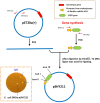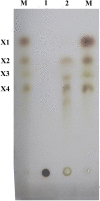Characterization of a GH10 extremely thermophilic xylanase from the metagenome of hot spring for prebiotic production
- PMID: 37749183
- PMCID: PMC10520001
- DOI: 10.1038/s41598-023-42920-6
Characterization of a GH10 extremely thermophilic xylanase from the metagenome of hot spring for prebiotic production
Abstract
A xylanase gene (named xyngmqa) was identified from the metagenomic data of the Gumingquan hot spring (92.5 °C, pH 9.2) in Tengchong City, Yunnan Province, southwest China. It showed the highest amino acid sequence identity (82.70%) to endo-1,4-beta-xylanase from Thermotoga caldifontis. A constitutive expression plasmid (denominated pSHY211) and double-layer plate (DLP) method were constructed for cloning, expression, and identification of the XynGMQA gene. The XynGMQA gene was synthesized and successfully expressed in Escherichia coli DH5α. XynGMQA exhibited optimal activity at 90 °C and pH 4.6, being thermostable by maintaining 100% of its activity after 2 h incubated at 80 °C. Interestingly, its enzyme activity was enhanced by high temperatures (70 and 80 °C) and low pH (3.0-6.0). About 150% enzyme activity was detected after incubation at 70 °C for 20 to 60 min or 80 °C for 10 to 40 min, and more than 140% enzyme activity after incubation at pH 3.0 to 6.0 for 12 h. Hydrolytic products of beechwood xylan with XynGMQA were xylooligosaccharides, including xylobiose (X2), xylotriose (X3), and xylotetraose (X4). These properties suggest that XynGMQA as an extremely thermophilic xylanase, may be exploited for biofuel and prebiotic production from lignocellulosic biomass.
© 2023. Springer Nature Limited.
Conflict of interest statement
The authors declare no competing interests.
Figures






References
-
- Soni M, Mathur C, Soni A, Solanki MK, Kamboj DV. Xylanase in waste management and its industrial applications. Waste Energy: Prospect. Appl. 2020 doi: 10.1007/978-981-33-4347-4_16. - DOI
Publication types
MeSH terms
Substances
LinkOut - more resources
Full Text Sources

